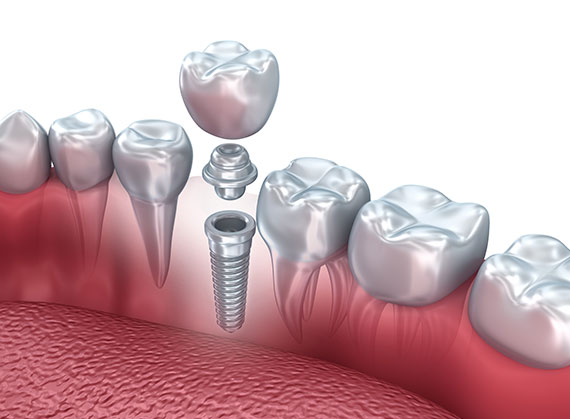Implantology
Implantology: What is a dental implant?
If you are missing a tooth, the simplest and most conservative thing is to have a dental implant. An implant is an artificial titanium root. The dentist screws it into the bone and a ceramic tooth can be attached to it. The adjacent teeth are not touched.
A dental implant consists of a titanium post that is inserted into the jaw bone in place of the missing natural tooth root, serving as a support for the new tooth. The implant is composed of two basic components, namely a part that corresponds to the root of the tooth that is inserted into the bone / gum during the surgical act and then another component that corresponds to the crown of the tooth that is screwed or cemented to the primary component / root via a connection abutment.
The implants transmit the chewing forces to the maxillary bone, which involves the preservation of the maxillary bone natural and helps support the structure of the face.
With conventional methods the replacement of a single dental element through the bridge would involve filing and therefore a considerable biological sacrifice of dental substance for the two teeth adjacent to the missing tooth and furthermore the bridge, not transmitting the chewing forces to the underlying bone, would not preserve the natural jaw bone.
Find out more

Moderna implantologia
Today with modern implantology it is possible to rehabilitate from a single tooth to mouths with many compromised dental elements or to completely edentulous mouths without any residual dental elements, and in all the aforementioned cases there are completely reliable standardized procedures that allow a quick and painless restoration of chewing function.
Healing phase
The healing phase following the implant placement operation lasts from 6 to 12 weeks , depending on the specific conditions of each patient, but in particularly favorable cases with the presence of bone in perfect condition , which allows immediate stability of the implant in contact with the bone, it is also possible to immediately put the tooth (crown) and then to practice the so-called immediate load, i.e. a temporary crown is placed on the implant on the same day implant placement surgery and then perform the definitive crown after a few weeks.
When implantology began to take its first steps, the prevailing tendency was to place patients who had some or no teeth at all, almost one implant for each missing tooth.
Implantology trend today
Today the trend is completely reversed and several scientific studies also support the rehabilitation of an entire dental arch using only 4 Implants in the “ALL on four” system and also if we tried to place the implants before parallel to each other and according to the chewing load axis for several years it has already been seen on a scientific level how even the tilted implants “tilted implants” present an excellent response in functional and biological terms so that unlike a few years ago in which extensive bone reconstruction interventions were often carried out precisely to have a correct insertion axis of the implants for the purpose of creating the prosthetic crowns (teeth), now the planning of angled implants allows to better exploit the availability of residual bone in the mouths of patients by bypassing sensitive anatomical structures (e.g. maxillary sinus, inferior alveolar nerve) and allowing interventions surgery with minimal invasiveness compared to yesterday.
Fixed restoration on four implants " ALL on four " implants
Chirurgia implantare computer guidata: implantologia senza bisturi
This is one of the most recent acquisitions in the field of implant surgery and allows the surgeon to perform implant positioning assisted by guide templates whose realization takes place digitally, using computerized software, following a programming on a CT scan. of the 3D position of the implant within the bone crest. This method in some cases, particularly favorable for the conditions of available bone volumes, allows the surgeon to avoid incision and opening of the gingiva with a scalpel and to consequently the need to give sutures as there is no solution of continuity or surgical wound to suture.

